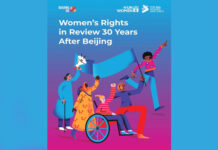New analysis from HR systems provider Ciphr has revealed that around 8 in 10 job roles in the UK pay men more per hour than women. According to the latest 2022 gender pay gap figures from the Office for National Statistics (ONS), the majority of UK occupations still have a pay gap that favours men.
Disappointingly, 79% of the job roles held by at least 50,000 workers or more, pay men more per hour on average. For job roles employing over 215,000 people that rises to 84% with a gender pay gap in favour of men. Only 2% of occupations with 50,000 plus workers have no reported pay gaps, and nearly one in five (19%) have gender pay gaps in favour of women.
Pay gaps vary considerably by role, ranging from -22.9% for special needs teachers to 0.2% for nurses and 30.1% for vehicle mechanics, revealed the report. There are also differences by industry, age, and geographical location. Across all employees in the UK, the ONS puts the average median gender pay gap at 14.9%. This means that women, on average, earn 85p for every pound earned by a man.
GENDER PAY DISPARITIES
Ciphr’s gender pay gap study, based on the latest official data from the ONS – found that around 19 million workers are employed in occupations with a gender pay gap of 1% or higher in favour of men. This signals that, despite years of reforms and inclusive policies and initiatives aimed at reducing gender pay disparities, there’s still a long way to go to close the gap. This is especially the case for workers doing some of the most popular jobs in the UK.
The three occupations with the largest workforces, employing more than 2.2 million people in 2022, are nurses (other nursing professionals), sales and retail assistants, and care workers and home carers. The average gender pay gaps for those three occupational groups are 0.2%, 2.8%, and -1% respectively (in 2021, the pay gaps were 4%, 5%, and 1.7%).
Over half a million (576,500) employees hold administrative or clerical job roles, making it the fourth largest occupation in the UK. While nearly three-quarters (74%) of these workers are women, it has an 8.9% gender pay gap in favour of men (it was 10.5% in 2021).

MOST POPULAR JOBS & PAY GAPS
Indeed, women make up the majority (60% or higher) of the workforce in seven of the top ten jobs with the largest number of employees, yet all but two have gender pay gaps in favour of men. Comparable data does show, however, that most jobs with over 215,000 employees have narrowed their gender pay gaps since 2021.
The most popular jobs in the UK (and their gender pay gaps), ranked by number of people employed:
- Other nursing professionals – including nurses: 814,000 employees (0.2% gender pay gap)
- Sales and retail assistants: 737,400 employees (2.8%)
- Care workers and home carers: 731,100 employees (-1.0%)
- Other administrative occupations – including admin and clerical assistants: 576,500 employees (8.9%)
- Warehouse operatives: 542,000 employees (5.7%)
- Sales accounts and business development managers: 476,800 employees (8.8%)
- Kitchen and catering assistants: 443,000 employees (-1.1%)
- Programmers and software development professionals: 439,700 employees (11.7%)
- Nursing auxiliaries and assistants: 438,600 employees (1.4%)
- Book-keepers, payroll managers and wages clerks: 401,100 employees (6.5%)
The only occupations with over 50,000 employees that have no reported gender pay gaps for 2022 are retail cashiers and check-out operators, bar staff, and buyers and procurement officers.

JOBS WITH NARROWEST PAY GAPS
Some of the occupations that have the narrowest pay gaps (of between 0.9% and -0.9%) include pharmacists, primary school teachers, civil engineers, chefs, data analysts, and HR officers. Interestingly, the gender pay gap for HR managers and directors is much higher at 6.5%.
It’s also worth noting that over three million employees work in occupations with a negative gender pay gap of -1% or more (roles which pay women more on average). Some examples include waiters and waitresses, IT operations technicians, hairdressers and barbers, call centre workers, midwives, GPs, and PAs.
The report also revealed that pay gaps persist in female-dominated full-time careers. Ciphr researchers also investigated whether occupations with a greater proportion of female full-time employees than male full-time employees have widespread gender pay gaps. It turns out that most female-dominated occupations (job roles where over 60% of workers are women) do have gender pay gaps in favour of men.
Over two-thirds (68%) of female-dominated occupations, which employ 50,000 full-time workers or more, have gender pay gaps in favour of men. Just 3% have no pay gaps, and the remaining 29% have gender pay gaps in favour of women.
PAY GAPS IN MALE-DOMINATED ROLES
In comparison, 90% of male-dominated occupations with 50,000 plus full-time workers (where over 60% of people in these roles are men), also have gender pay gaps in favour of men. Just 10% have gender pay gaps in favour of women.
Some of the female-dominated occupations with the largest gender pay gaps for full-time workers in favour of men include legal associate professionals, such as conveyancers, paralegals, and law clerks (18.1% pay gap), other health professionals – including dieticians, physiologists, and mental health workers (11.7%), office managers (10.4%), and public relations professionals (8.9%).
It’s a similar picture for entire occupational groups (the UK’s workforce is split into 26 sub-major groups by the ONS). Take full-time health professionals, for example. Although its workforce is predominantly female (around seven women to three men), it has the second widest pay gap at 14%.
PAY GAPS IN TRAVEL & LEISURE
Workers in leisure, travel, and related personal service occupations – which has a more balanced workforce split of 57% women and 43% men – also have to contend with a significant 11% pay gap (the fifth biggest in the UK).
Six out of seven female-dominated occupational groups – including health and social care associate professionals, administrative occupations, teaching and other educational professionals, and caring personal service occupations – have pay gaps over 2% that favour men. Secretarial and related occupations is the only exception at -6.6%.
Occupational groups with the largest proportion of women in the workforce, ranked by widest gender pay gaps in 2022:
| Occupation | Average median gender pay gap for full-time workers | Number of full-time workers (Jan-Dec 2021) | % of women in the workforce |
| Health professionals | 14% | 897,000 | 70% |
| Leisure, travel and related personal service | 11% | 244,400 | 57% |
| Health and social care associate professionals | 7.6% | 370,700 | 66% |
| Administrative occupations | 5.3% | 1,874,300 | 61% |
| Teaching and other educational professionals | 5.1% | 1,170,200 | 64% |
| Caring personal service occupations | 2.4% | 1,412,900 | 81% |
| Secretarial and related occupations | -6.6% | 321,000 | 88% |
GENDER PAY GAP WIDENS WITH AGE
The report also found that the gender pay gap widens with age. Among its many findings, Ciphr’s study highlights the scale of pay disparities for workers over 40 years old, compared to those under 40 years old. According to the ONS’ figures, the gender pay gap for full-time workers jumps from 3.2% for people in their thirties to 10.9% for those in their forties (and higher still for those over 50).
The pay gap data for occupational groups that have workforces of over a million people or more, all show similar increases. Business and public service associate professionals see one of the biggest rises, from 7.7% for workers aged 30-39 to 15.2% for those aged 40-49.
There’s also around a 5% increase in the gender pay gaps for caring personal service occupations and administrative occupations – from -0.5% for 30-39 year-olds to 5.2% for 40-49 year-olds, and 4.1% for 30-39 year-olds to 9.1% for 40-49 year-olds respectively.
STEM GENDER PAY GAP
The largest occupation, with over 2.1 million full-time employees, is science, engineering and technology associate professionals. The gender pay gap for STEM professionals in their twenties is 2.3%, in their thirties it’s 8.3%, and by their forties it’s 12.2%.
“The latest gender pay gap reports are disappointing, to say the least, especially given the ever-increasing spotlight on inclusive policies and initiatives and pressure for employers to close the gap,” stated Claire Williams, Chief People Officer at Ciphr. “It is particularly worrying to see the increase in the gender pay gap for those aged 40 and above. There will be multiple reasons for this but is most likely a result of the ‘motherhood penalty’ – where working mothers may need part-time roles or more flexible working arrangements to support their children and families, and find that the need for such roles limits their progression up the career ladder. Many women also have to battle against assumptions around lower perceived competence and commitment, higher professional expectations, lower likelihood of hiring and promotion, and lower recommended salaries. Any of these factors can have a big impact on women being given fair and equal opportunities and pay.”
PAY GAP REPORTING
Williams believes far more needs to be done, and quickly, to hold employers accountable. “More robust gender pay gap reporting, an overhaul of the childcare support available to working parents, making flexible working the norm, and an introduction of measures to minimise the disproportionate impact of the cost-of-living crisis on women in particular. And, of course, better representation of women and ethnic minorities at all levels, in all roles, is vital to driving change in an organisation. It’s also the best way of attracting and retaining the best employees,” Williams concluded.
Check out the full report here.







































